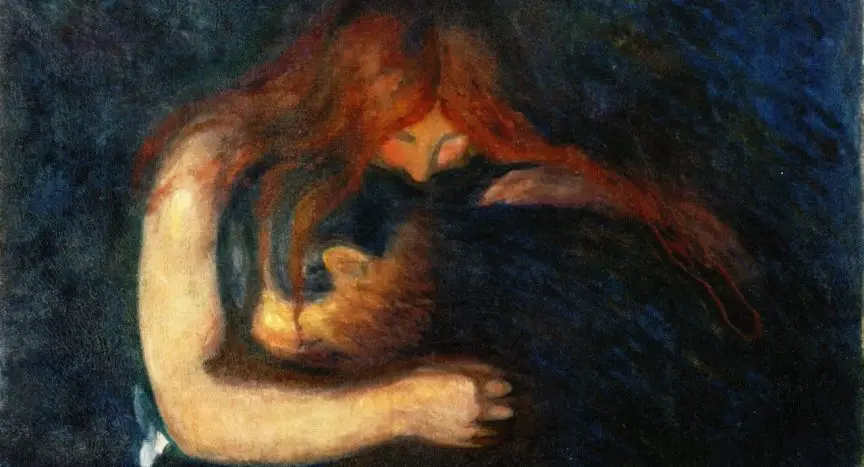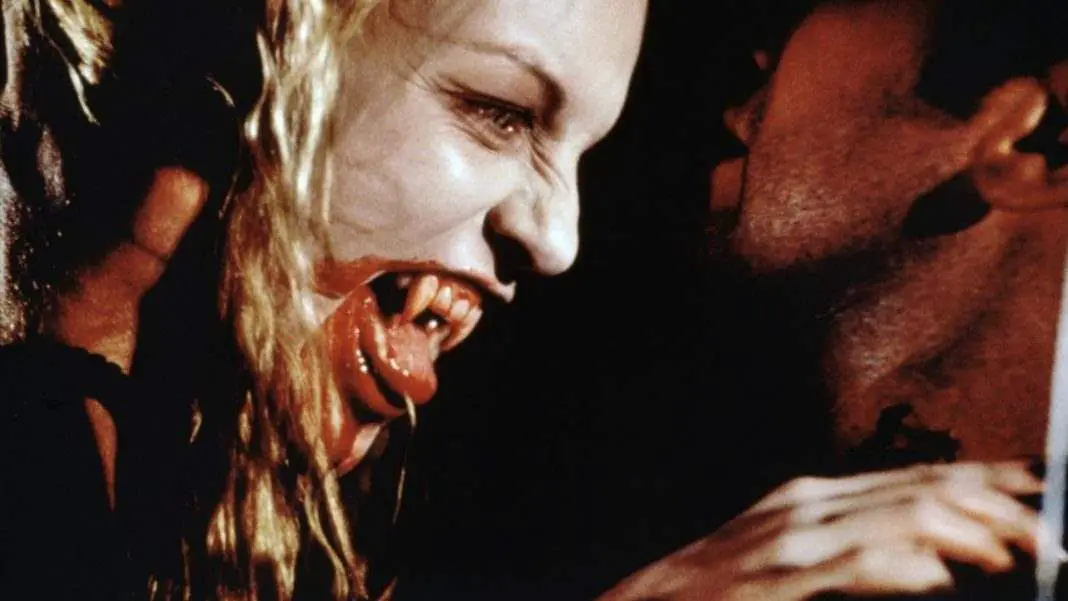Bram Stoker’s brilliant epistolary novel has terrified readers and inspired artists of all stripes since the 1890s. But Dracula isn’t the only blood-thirsty night-prowler who’s been around since Queen Victoria. The nineteenth century produced a wonderful diversity of vampire classics. You’ll find bloodsuckers in novels, short stories, penny dreadfuls, poetry and plays. They questioned sexuality, gender, religion, economy and politics. They were peasants, aristocrats, invalids, scientists and (of course) passionate lovers. Sure, there’s only one Count. But there’s loads more for you to bite into. So let’s get counting. One vampire, ah ah ah! Two vampires, ah ah ah! …
Also See: Five Vampire Movies That Don’t Make Their Vampires Sexy
Carmilla by Sheridan Le Fanu
Carmilla is one of the 19th century’s best-known vampire classics to modern anglophone readers. Laura, the young protagonist, forms a friendship with Carmilla, who’s staying with her and her father for three months. As would be expected with a vampire, the relationship is physical; but Le Fanu doesn’t stop there. In language and action, Carmilla treats Laura as a lover and their relationship as a union. The vampire is still a monster. So I definitely wouldn’t say that Le Fanu presents a full-throated defense of lesbian desire. But Carmilla still anticipates modern arguments connecting queerness and genetics. That might be one of the reasons the novella has been experiencing a revival. Either way, this beautifully-written story deserves its continued popularity.
Also See: You And I Are One Forever: Why Carmilla Remains One of the Most Important Vampire Stories Ever Told

Clarimonde by Théophile Gautier
Centuries before Twilight, the French were already writing vampire romances. Théophile Gautier’s novella Clarimonde is one of those Gallic vampire classics. This love story between Romuald and Clarimonde, a young priest and a vampire, feels alternately of its time and modern. Gautier’s lush prose, with its literary flourishes and adjectival acrobatics, flies us on batwings right into the 19th century. When Romuald and Clarimonde fall in love, it’s immediate and intense. Yet Gautier portrays the relationship delicately. They truly love each other, and to a certain extent, depend on each other. The religious morality is black and white. But the portrayal of the Church instilling a fear of love and sense of self-hatred in Romuald is subtly anti-clerical as well. In Clarimonde, Gautier doesn’t make a saint out of his vampire. But he doesn’t flinch at showing the Church’s demons as well.

Good Lady Ducayne by Mary Elizabeth Braddon
Mary Elizabeth Braddon was best known for her sensation novels, but she was also a prolific horror writer. Good Lady Ducayne is a wonderful example of what she could do. It’s a creepy short story with feminist critiques on class and science pulsing under its skin. To support her mother, Bella Rolleston looks for a job as a companion to wealthy women. She takes a position in Italy with the incredibly old Lady Ducayne and her waxen-faced physician, Dr. Parravicini. Initially in the bloom of health, marks begin to appear on Bella’s arm. As her health deteriorates, she tries to find out if they’re bites or something even more sinister. Medicine is pitted against nature and the wealthy against the poor. But most interestingly, women support and destroy each other in equal measure. Writers who can address so much in elegant and clear prose are rare.
Also See: The Modern Vampire: Six Stories That Influenced Dracula

Varney, the Vampyre by James Malcom Rymer and Thomas Peckett Prest
The size of Varney the Vampyre often scares readers away. Fair enough. Just lifting this 1168 page tome (that’s the small print version) will give your biceps a workout. But Varney was never meant to be read like a modern novel. It was written for penny dreadfuls and is better enjoyed in small bites, one chapter at a time.
The initial story shows Varney tormenting the formerly-wealthy Bannerworth family. But once that plotline is exhausted, instead of ending, the book follows more of Varney’s exploits. Sometimes you’ll get full stories, sometimes vignettes. They range from scary to gloomy to comic to tragic and new chapters sometimes introduce an entirely new world. Anyone who needs an airtight backstory to enjoy the book should probably sink their teeth into some other 1000 page tomb. As you read, Varney’s biography becomes riddled with contradictions. But anyone who can accept the natural inconsistencies of a penny dreadful will get pure, concentrated entertainment from this influential classic.

The Thousand and One Ghosts by Alexandre Dumas
While Alexandre Dumas is better known for his swashbuckling stories about musketeers and intrigue in the French nobility, he also wrote a wonderful collection of ghost stories. And like many of his contemporaries, he couldn’t resist the draw of the vampire story for the last tale in this collection.
A Polish princess takes refuge from invading Russian forces at the home of a Moldavian noblewoman and her two sons. Of course the sons fall in love with the beautiful refugee and are willing to go to extremities to win her hand. It wouldn’t be a Dumas piece without a little sword-swinging. So for his foray into Gothic literature, he draws from vampiric traditions where a blade is more useful than a stake. What else would you expect from the 19th century’s Quentin Tarantino? Nobody could write a fight scene like him and he knew it. It deserves to be counted amoung the vampire classics. Give The Thousand and One Ghosts a chance any you’ll be reading it from dusk till dawn.

The Blood of the Vampire by Florence Marryat
Florence Marryat’s unique, problematic and extremely original novel was published in 1897, the same year as Stoker’s Dracula. The story follows a pair of English families who meet the young, Jamaican heiress Harriet Brant. She charms them with her mix of unbridled affection and ignorance. But anyone who gets close to Miss Brant starts feeling weak and sickly, sometimes with fatal results.
Far too Victorian for fangs and gore, Marryat makes her vampires psychic life-drainers rather than coffin-dwelling neck-biters. The prose is playful and sharp, blending wit with observation and emotion effortlessly. I’m certain that critics in the last century ignored the book because the writer was a woman. But I can’t recommend this book unreservedly. Blurbs online say that the book deals with issues of the time, notably race.
That statement is weak to the point of being misleading. The book doesn’t explore the issue so much as it presents an unfiltered example of the 19th century’s casual racism. Marryat doesn’t revel in it as blatantly as writers like Lovecraft. But is this an example of an author presenting an objective portrayal of her time? No. This novel has heroes. And when the heroes speak about race, they use the language of scientific racism, eugenics and oppression. No character questions the gratuitous, violent racism peppered throughout the novel. Anyone reading it should be clear-eyed about that. It mars what would have otherwise been one of the great vampire classics in terms of style, story and character.
See Also: Seven Horror Movies You Didn’t Know Were Written by Women

Vampire City by Paul Féval
Paul Féval is one of France’s best known writers of vampire classics from the 19th century. With Vampire City he’s also a pioneer in fan fiction. Ann Radcliffe, England’s original queen of Gothic literature, leads a motley crew of friends, servants and one gender-fluid vampire to the undead capital to rescue a childhood friend.
Though blurbs call the book a precursor to Buffy the Vampire Slayer, you won’t see Miss Radcliffe backflipping over hellmouths and decapitating demons. However, it has a similar appeal and is perfect for fans of kitsch horror. The fight scenes are both tense and slapstick. The vampires are creepy; but at times they resemble supernatural mosquitos more than deadly night-prowlers. Miss Radcliffe’s international band of allies are often groan-worthy stereotypes. But they’re all weirdly touching and the warmth that Féval felt for them comes out in the writing. If you’re looking for a fun mix of vampiric chaos and comedy, this is the book for you.

Olalla by Robert Louis Stevenson
As Stevenson was proofing The Strange Case of Dr Jekyll and Mr Hyde, he wrote this short story set in the Napoleonic Wars. An English soldier in Spain is convalescing from his wounds in the residence of an old aristocratic family. He’s advised not to become familiar with the family; and in charming British fashion, he ignores the warning. Stevenson filled this piece to the brim with gothic tropes: invalids, ancient castles, ghostly portraits, forbidden love and crumbling aristocracy. It’s open to interpretation whether the bloodthirsty characters are vampires or simply humans who have degenerated to vessels of bestial impulses. But this story has a clear place amoung the vampire classics for its emphasis on the importance of blood. Notably, the weak blood of aristocracy versus the healthy blood of soldiers fighting the emperor Napoleon.

The Flowers of Evil by Charles Baudelaire
We’ll finish with one for the poetry lovers out there. Literary bad boy Charles Baudelaire found inspiration in the vampiric as well. It won’t surprise fans of Edgar Allen Poe to find out that Baudelaire was his French translator. In this poem, see how he turns our expectations of who’s the victim and who’s the vampire on its head. It’s one of the many masterpieces from the brilliant collection The Flowers of Evil.
The Vampire
You, who like a dagger ploughed
Into my heart with deadly thrill:
You who, stronger than a crowd
Of demons, mad, and dressed to kill,
Of my dejected soul have made
Your bed, your lodging, and domain:
To whom I’m linked (Unseemly jade!)
As is a convict to his chain,
Or as the gamester to his dice,
Or as the drunkard to his dram,
Or as the carrion to its lice —
I curse you. Would my curse could damn!
I have besought the sudden blade
To win for me my freedom back.
Perfidious poison I have prayed
To help my cowardice. Alack!
Both poison and the sword disdained
My cowardice, and seemed to say
“You are not fit to be unchained
From your damned servitude. Away,
You imbecile! since if from her empire
We were to liberate the slave,
You’d raise the carrion of your vampire,
By your own kisses, from the grave.”
— Roy Campbell, Poems of Baudelaire (New York: Pantheon Books, 1952)



